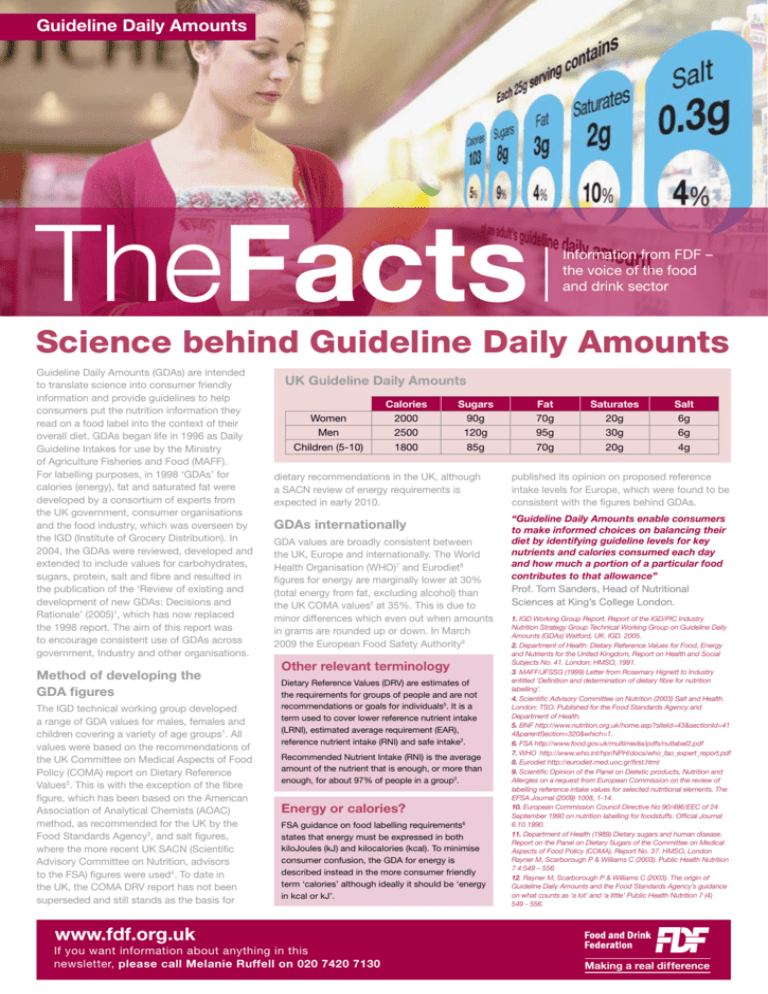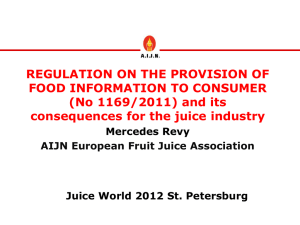The Facts: Science behind Guideline Daily Amounts
advertisement

Guideline Daily Amounts TheFacts Information from FDF – the voice of the food and drink sector Science behind Guideline Daily Amounts Guideline Daily Amounts (GDAs) are intended to translate science into consumer friendly information and provide guidelines to help consumers put the nutrition information they read on a food label into the context of their overall diet. GDAs began life in 1996 as Daily Guideline Intakes for use by the Ministry of Agriculture Fisheries and Food (MAFF). For labelling purposes, in 1998 ‘GDAs’ for calories (energy), fat and saturated fat were developed by a consortium of experts from the UK government, consumer organisations and the food industry, which was overseen by the IGD (Institute of Grocery Distribution). In 2004, the GDAs were reviewed, developed and extended to include values for carbohydrates, sugars, protein, salt and fibre and resulted in the publication of the ‘Review of existing and development of new GDAs: Decisions and Rationale’ (2005)1, which has now replaced the 1998 report. The aim of this report was to encourage consistent use of GDAs across government, Industry and other organisations. Method of developing the GDA figures The IGD technical working group developed a range of GDA values for males, females and children covering a variety of age groups1. All values were based on the recommendations of the UK Committee on Medical Aspects of Food Policy (COMA) report on Dietary Reference Values2. This is with the exception of the fibre figure, which has been based on the American Association of Analytical Chemists (AOAC) method, as recommended for the UK by the Food Standards Agency3, and salt figures, where the more recent UK SACN (Scientific Advisory Committee on Nutrition, advisors to the FSA) figures were used4. To date in the UK, the COMA DRV report has not been superseded and still stands as the basis for UK Guideline Daily Amounts Women Men Calories 2000 2500 Sugars 90g 120g Fat 70g 95g Saturates 20g 30g Salt 6g 6g Children (5-10) 1800 85g 70g 20g 4g dietary recommendations in the UK, although a SACN review of energy requirements is expected in early 2010. published its opinion on proposed reference intake levels for Europe, which were found to be consistent with the figures behind GDAs. GDAs internationally “Guideline Daily Amounts enable consumers to make informed choices on balancing their diet by identifying guideline levels for key nutrients and calories consumed each day and how much a portion of a particular food contributes to that allowance” Prof. Tom Sanders, Head of Nutritional Sciences at King’s College London. GDA values are broadly consistent between the UK, Europe and internationally. The World Health Organisation (WHO)7 and Eurodiet8 figures for energy are marginally lower at 30% (total energy from fat, excluding alcohol) than the UK COMA values2 at 35%. This is due to minor differences which even out when amounts in grams are rounded up or down. In March 2009 the European Food Safety Authority9 Other relevant terminology Dietary Reference Values (DRV) are estimates of the requirements for groups of people and are not recommendations or goals for individuals5. It is a term used to cover lower reference nutrient intake (LRNI), estimated average requirement (EAR), reference nutrient intake (RNI) and safe intake2. Recommended Nutrient Intake (RNI) is the average amount of the nutrient that is enough, or more than enough, for about 97% of people in a group2. Energy or calories? FSA guidance on food labelling requirements6 states that energy must be expressed in both kiloJoules (kJ) and kilocalories (kcal). To minimise consumer confusion, the GDA for energy is described instead in the more consumer friendly term ‘calories’ although ideally it should be ‘energy in kcal or kJ’. 1. IGD Working Group Report. Report of the IGD/PIC Industry Nutrition Strategy Group Technical Working Group on Guideline Daily Amounts (GDAs) Watford, UK. IGD. 2005. 2. Department of Health. Dietary Reference Values for Food, Energy and Nutrients for the United Kingdom, Report on Health and Social Subjects No. 41. London: HMSO, 1991. 3. MAFF/JFSSG (1999) Letter from Rosemary Hignett to Industry entitled ‘Definition and determination of dietary fibre for nutrition labelling’. 4. Scientific Advisory Committee on Nutrition (2003) Salt and Health. London: TSO. Published for the Food Standards Agency and Department of Health. 5. BNF http://www.nutrition.org.uk/home.asp?siteId=43&sectionId=41 4&parentSection=320&which=1. 6. FSA http://www.food.gov.uk/multimedia/pdfs/nutlabel2.pdf 7. WHO http://www.who.int/hpr/NPH/docs/who_fao_expert_report.pdf 8. Eurodiet http://eurodiet.med.uoc.gr/first.html 9. Scientific Opinion of the Panel on Dietetic products, Nutrition and Allergies on a request from European Commission on the review of labelling reference intake values for selected nutritional elements. The EFSA Journal (2009) 1008, 1-14. 10. European Commission Council Directive No 90/496/EEC of 24 September 1990 on nutrition labelling for foodstuffs. Official Journal 6.10.1990. 11. Department of Health (1989) Dietary sugars and human disease. Report on the Panel on Dietary Sugars of the Committee on Medical Aspects of Food Policy (COMA). Report No. 37. HMSO, London Rayner M, Scarborough P & Williams C (2003). Public Health Nutrition 7 4:549 – 556. 12. Rayner M, Scarborough P & Williams C (2003). The origin of Guideline Daily Amounts and the Food Standards Agency’s guidance on what counts as ‘a lot’ and ‘a little’ Public Health Nutrition 7 (4) 549 - 556. www.fdf.org.uk If you want information about anything in this newsletter, please call Melanie Ruffell on 020 7420 7130 Making a real difference Calories/energy Salt/sodium Men Women 2500 kcal/day 2000 kcal/day Men Women Salt 6.0g 6.0g Sodium* 2.4g 2.4g • Based on the Estimated Average Requirement (EAR) for energy set out in the COMA report on Dietary Reference Values 19912 *required for labelling purposes • The EARs for 19-50 year olds are 1940 kcal/day for women and 2550 kcal/day for men • Salt: developed in line with the recommendations of SACN Report on Salt and Health (2004)4 • The 1998 IGD values rounded figures to 2000 kcal/day for women and to 2500 kcal/day for men • Sodium: based on the RNI for sodium multiplied by 1.5 (i.e. 2.4 x 1.5) in line with the rationale for the calculation of the SACN salt values. Developed to comply with EU labelling rules10 • Academic experts in energy metabolism were consulted and agreed that the 1998 IGD figures were still applicable • The GDA for calories/energy is an average target guideline Fat and saturated fat Men Women Fat 95g 70g Saturated fat 30g 20g • Based on the COMA report on Dietary Reference Values for energy (described above) 19912 and the IGD values developed in 1998 • Calculated using 33% energy from fat • Calculated using 10% energy from saturated fat • Grams to energy conversion figure for fat of 9 kcal/g • The GDAs for fat and saturated fat are maximum target guidelines Fibre Men Women NSP 18g 18g AOAC* 24g 24g *required for labelling purposes • NSP Fibre GDA: Based on the COMA report on Dietary Reference Values in relation to Non Starch Polysaccharides (NSP), based on the Englyst method of analysis2 • COMA recommended2 that an intake of 18g dietary fibre was needed to result in a healthy bowel habit (i.e. a daily faecal weight of at least 100g/day), with identical levels for men and women, since there is no sex difference in what is considered a healthy faecal weight and intake is independent of energy intake • The GDAs for sodium and salt are maximum target values Total sugars Men Women Total carbohydrate 300g 230g (Total sugars*) 120g 90g (NMES) 65g 50g *required for labelling purposes • The GDA for total carbohydrates was based on COMA recommendations for total energy intake2 (including alcohol) and calculated using 47% energy from carbohydrate • The GDA for non-milk extrinsic sugars (NMES) is based on the COMA 1991 DRV2 and the COMA 1989 Dietary sugars and human disease report11 and was calculated using 10% energy from NMES • The GDA for total sugars was developed using calculations as described* by Rayner et al 200312. This GDA is consistent with dietary recommendations for consuming 5-A-Day fruit and vegetables, three portions of dairy products and limiting added sugar intake to 10% of total energy. The 90g value for women and 120g value for men was developed to include intrinsic and milk sugars from some dairy products, fruit-based products and muesli, potato products and bread • The GDA for total sugars was developed to satisfy EU labelling law10, which requires that total sugars be calculated and displayed and was calculated using 19% energy from total sugars • Estimates of total sugars, non milk extrinsic sugars, non-milk intrinsic sugars and milk sugars are derived from the National Diet and Nutrition Survey for Adults and are 20%, 13% 5% and 2% food energy respectively • Grams to energy conversion figure for carbohydrates of 4 kcal/g • The GDA for carbohydrate is a minimum target guideline • The GDA total sugar is an average target guideline • The GDA for NMES is a maximum target guideline • AOAC Fibre GDA: Based on the Association Dedicated to Excellence in Analytical Methods (AOAC) method of analysis of fibre, in line with FSA recommendation on fibre analysis3, also the methodology used for labelling purposes throughout Europe *Rayner and colleagues calculated that the population average intake for total sugars should be approx 20% food energy intake (i.e. 11% NMES + 7% intrinsic sugars + 2% milk sugar). • The AOAC method for fibre content in foods tends to result in fibre values being approximately one third higher than those obtained using Englyst NSP values6. Hence the AOAC value of 24g was recommended by the IGD technical group as a suitable GDA for fibre One set of adult values • The GDA for fibre is a minimum amount All information is adapted from the IGD Working Group Report1 unless otherwise stated. To discourage over-consumption, particularly amongst those with low energy requirements, it was agreed that the GDA values currently used for women be used as the “All Adults” figure. This also prevents the confusion of employing a new set of values based on the average GDA between males and females. www.fdf.org.uk If you want information about anything in this newsletter, please call Melanie Ruffell on 020 7420 7130 Making a real difference






